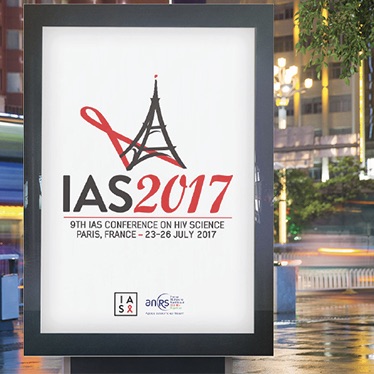An ongoing dialogue on HIV/AIDS, infectious diseases,
July 30th, 2017
Really Rapid Review — Paris IAS 2017
 Last week, the International AIDS Society meeting returned to Paris for the first time since 2003.
Last week, the International AIDS Society meeting returned to Paris for the first time since 2003.
Yes, you and I are that old. Jeeze.
Here’s a Really Rapid Review® of some of the conference highlights, roughly ordered by “cure”, prevention, treatment, and complications.
As always, feel free to use the comments section for notable studies I might have missed — thank you!
- A child remains “in remission”, with an undetectable viral load for over 8 years after stopping treatment. This case — similar the “Mississippi baby” but with no relapse — has no detectable HIV RNA in blood, small amounts of detectable HIV DNA, no replication competent virus, and none of the HIV immune responses typically seen in HIV controllers. Treatment course was 40 weeks around two months after birth as part of a clinical trial. One of my colleagues says it’s the closest thing to a “cure” since Timothy Ray Brown, though for obvious reasons it’s always risky to use that word.
- What happens when HIV is treated extremely early after HIV acquisition? A man on PrEP was diagnosed with an HIV RNA of 220, 4th generation Ag/Ab negative, around 10 days after acquiring HIV. He was treated for 34 months with combination ART, which led to numerous negative reservoir assays, then stopped treatment — only to experience virologic rebound (same as original infecting virus) 225 days later. In summary, reservoir and viral diversity were reduced — but virus not eradicated.
- More evidence that undetectable on treatment means a person won’t transmit HIV. There were zero HIV transmissions in 343 serodiscordant MSM couples followed an average of 1.5 years — which included an estimated 12,000 acts of condomless anal intercourse.
- “On demand” pre-exposure prophylaxis (PrEP) worked in the IPERGAY study even in those with less frequent sex. The regimen was 2 pills of TDF/FTC before sex, then one each of the next two days (4 total). Strategy was protective even in those taking 15 or fewer pills/month.
- Cabotegravir with every 8 week dosing looks good for PrEP. Pharmacokinetics somewhat different in men vs women, but these results demonstrate levels likely to be protective with every 8 week dosing after a 4-week loading dose. Phase 3 comparative study vs. TDF/FTC ongoing.
- Weekly MK-8591 effective in animal model of PrEP. The drug, a “nucleoside reverse transcriptase translocation inhibitor” with a mechanism of action somewhat different from current NRTIs, is highly potent with a long half life. Study used rhesus macaques and SIV; none became infected after SIV challenge that infected untreated controls.
- New HIV diagnoses in MSM have declined slightly in the USA since 2008. The reduction is steepest among men aged 34-44 and in whites, while rates are increasing in younger men (13-34), and in Hispanics, younger blacks.
- Bictegravir/FTC/TAF non-inferior to dolutegravir/ABC/3TC in treatment-naive patients. 92.4% vs 93.0% < 50 at week 48. Significantly less nausea in BIC/FTC/TAF arm, but both regimens very well tolerated. No difference in bone outcomes. No resistance in either treatment arm.
- BIC/FTC/TAF non-inferior to DTG + FTC/TAF in treatment-naive patients. 89.4% vs 92.9% < 50 at week 48. Again, no emergent resistance in any of the few study subjects with treatment failure. This BIC/FTC/TAF regimen is under review by the FDA; if approved, it could be available early next year. (Disclosure: I was the presenting investigator.)
- Doravirine/TDF/3TC non-inferior to EFV/TDF/FTC. 84% vs 81% < 50 at week 48. DOR with significantly fewer CNS side effects, better lipids. 1.6% of DOR vs 3.3% of EFV subjects with resistance. Results of this and prior phase 3 DOR study suggest this NNRTI has the best efficacy, safety, and tolerability profile in this drug class.
- Single-arm study (n=120) of DTG + 3TC demonstrated 90% success (HIV RNA < 50) at week 24. Good news, it seemed to work well even in the 25% with baseline HIV RNA > 100K. Less good news, one study subject (in the < 100K group) developed 3TC and possibly integrase resistance (a K263K/R mixture). Contrast this with zero resistance in any of the triple-therapy studies of DTG. Phase 3 comparative studies of DTG + 3TC ongoing.
- 3TC was non-inferior to TDF/3TC when given with fixed-dose DRV/r. With the caveat that this is an interim analysis of a fully powered study, and used a 400 copy/mL threshold, the results are encouraging — and DRV/r + 3TC is a much more attractive regimen than the LPV/r + 3TC regimen used in GARDEL. Note the use of a non-FDA approved DRV/r coformulation (study done in Argentina). In the USA, this would presumably be DRV/c, can we extrapolate?
- Switching to a single-pill coformulation of DRV/c/FTC/TAF was non-inferior to continuing a boosted PI. If approved, this would be the first boosted PI single-tablet regimen. A treatment-naive study (compared to DRV/c, TDF/FTC) is also ongoing.
- With 2 NRTIs, DTG superior to LPV/r as 2nd-line therapy after failure of a 2-NRTI/NNRTI-based regimen. The results so favored the DTG strategy that the study’s Independent Data Monitoring Committee stopped the LPV/r arm (all subjects are now receiving DTG). Findings should have a huge impact on clinical practice — will DTG (not boosted PI) based regimens now be the standard of care for second-line therapy? Can we extrapolate to those currently virologically suppressed on boosted PIs + NRTIs due to NRTI resistance?
- In patients with advanced HIV disease, adding maraviroc to standard ART did not improve clinical outcome. This was a very well done trial, negative results notwithstanding. More studies in this challenging patient population needed!
- DTG + TDF/FTC is as safe as TDF/FTC/EFV in pregnancy. Reassuring analysis of nearly 845 DTG-treated and 4593 EFV-treated pregnancies in Botswana, as infant outcomes were similar. A randomized study of TAF/FTC + DTG in pregnancy is ongoing.
- Raltegravir also appears safe in pregnancy. Pending results of ongoing studies, raltegravir plus TDF/FTC is our current go-to regimen in pregnancy — where it is much better tolerated than boosted PIs.
- Every 4 week or every 8 week injectable cabotegravir plus rilpivirine maintains virologic suppression. No additional cases of virologic rebound occurred between weeks 48-96 (there was one in the q8 week arm initially). The every 8 week strategy was nearly superior to oral therapy. Fully powered phase 3 studies of CAB/RPV given q 4 weeks are ongoing.
- A single dose of MK-8591 suppresses HIV RNA for at least a week. A dose as low as 0.5 mg achieved this effect, demonstrating extraordinary potency. One patient (according to the presenter) had prolonged suppression even after stopping therapy (he/she was supposed to go on standard ART).
- In patients at high CV risk, a switch from boosted PIs to DTG maintains virologic suppression, improves CV risk profile. Eligible subjects had no prior treatment failures. Lipid benefits were particularly beneficial with the DTG switch, similar to what was seen in SPIRAL and SWITCHMRK, both of which involved switching from boosted PIs to raltegravir.
- Zoledronic acid improves bone mineral density more than switching off TDF. Of course in patients with low bone density, clinicians should probably employ both strategies given the increasing availability of TAF.
- Telomere length is worsened by smoking (especially) and viremia. I cite this study since this molecular observation so strongly correlates with anecdotal clinical experience — so many of the patients I follow with “accelerated aging” have an extensive smoking or viremia history. Or worse, both.
- Glecaprevir/pibrentasvir highly effective in HIV/HCV co-infected patients. Strategies tested were 8 weeks for no cirrhosis (n=137), 12 weeks for cirrhosis (n=14), with 150/151 cured. This “G/P” pan-genotypic regimen is likely to be FDA-approved soon, and can be used with any integrase or RPV-based HIV regimen.
- Large (n = 721) randomized clinical trial of cryptococcal meningitis in Africa finds 1 week of amphotericin + 5FC is the best strategy. Note that fluconazole + 5FC (an all-oral regimen) was nearly as good, underscoring the need to make 5FC more readily available in resource-limited settings, as amphotericin treatment is not always feasible.
- Use of adjunctive corticosteroids in PCP does not adversely influence subsequent CD4 recovery. I’ve always wondered about this! Now we know.
Now for a few non-scientific observations:
-
The weather was mostly, cool, cloudy, and intermittently wet. Regardless, Paris is among the most beautiful and lively cities in the world. (Not such an original opinion, I know.)
- A bike race visited Paris at the same time. Lots of excitement.
- What a weird conference center. Numerous escalators, winding hallways, and a disorienting layout made getting around tricky. At least the session halls for the slide sessions were very comfortable (though some over-crowded).
- Why can’t we have a subway system like that? The Paris Metro seems to get better all the time — fast, clean, reliable, inexpensive. I’m sure it’s not perfect, but is there a better urban rapid transit system in a large city anywhere else?
- Although per capita cigarette consumption is roughly the same in France and the USA, it sure doesn’t seem that way. I’ll anecdotally say that lots of professionals (even doctors, gasp) and other well-to-do people smoke in France — you don’t see that much in the USA anymore.
- Next year’s conference is in Amsterdam. July 23-27.
Speaking of bicycling around Paris …
[youtube https://www.youtube.com/watch?v=s8ErsO92Bfw]
Save




Hi Paul! Excellent as usual!. The other important topic is the great attention to anti/PD1 compounds as potential remission therapy. This was extensively discussed also in the previous forum that mixed Cancer and HIV as paradigm for remision/cure.
Also worthy to mention the long long opening ceremony (we should do something more fun next time), but where we should mention the incredible intervention of the transgender activist.
Finally, U2 was in town!!!!!!!!!!!!!!!!!!!!!!!! Incredible show!!!!!!!!!!!!!!!!!!!!!!!!!!!!
Great replay Omar and agree that it is a very good summary of the most important topics at the IAS 2017… I would add that not only the City is beautiful, but the food fantastic!
I also went to U2 and yes… we are that old (30 years since Youshua Tree)
Thanks
Thanks so much Paul. One other intriguing report (Toledo etc all) was the population registry based analysis from South Africa that noted a modest reduction in HIV prevalne (and interestingly HSV-2 prevalence) among younger women who reported that their male partners were circumcised relative to those who were not. I’m eager to read this when it’s published as the methodology is quite interesting and there are obviously a number of limitations, but it’s in contrast to the Rakai prospective data and the fact that the prevalence of other STIs, notably syphilis and HSV2, aligned with those for HIV support the biological plausibility of this observation.
Outstanding summary!
Excellent meeting!!..very good summary.All Argentine proud with Dr Cahn and his group!!!
Hi Paul: Excellent succinct report. My 9 y/o grandson really enjoyed the “Paris is My Playground” video.
One correction about the case report of the child in HIV remission: The child’s treatment started around 2 months of age, not 1 month.
Thanks, will correct!
Paul